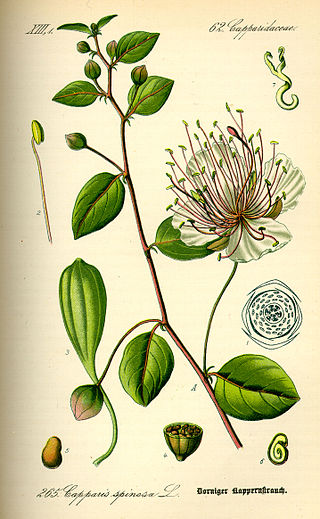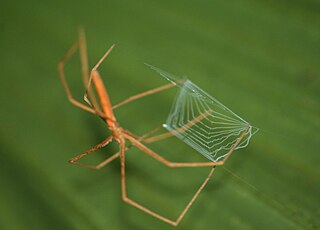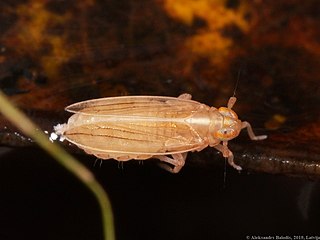
Capparis spinosa, the caper bush, also called Flinders rose, is a perennial plant that bears rounded, fleshy leaves and large white to pinkish-white flowers.

Prunus spinosa, called blackthorn or sloe, is an Old World species of flowering plant in the rose family, Rosaceae. It is locally naturalized in parts of the New World.

Aralia spinosa, commonly known as devil's walking stick, is a woody species of plant in the genus Aralia of the family Araliaceae. It is native to eastern North America. The various names refer to the viciously sharp, spiny stems, petioles and even leaf midribs. It has also been known as Angelica-tree.

Junín National Reserve is a protected area located in the region of Junín, Peru. One of its main purposes is to protect the ecosystem and biodiversity of Lake Junín and the surrounding Central Andean wet puna.

Bursaria spinosa is a small tree or shrub in the family Pittosporaceae. The species occurs mainly in the eastern and southern half of Australia and not in Western Australia or the Northern Territory. Reaching 10 m (35 ft) high, it bears fragrant white flowers at any time of year but particularly in summer. A common understorey shrub of eucalyptus woodland, it colonises disturbed areas and fallow farmland. It is an important food plant for several species of butterflies and moths, particularly those of the genus Paralucia, and native bees.

Abraxas grossulariata is a moth of the family Geometridae, native to the Palearctic realm and North America. Its distinctive speckled coloration has given it a common name of magpie moth. The caterpillar is similarly coloured to the adult, and may be found feeding on the leaves of shrubs such as gooseberry and blackcurrant. The species was first described by Carl Linnaeus in his 1758 10th edition of Systema Naturae.

Pyrus spinosa, the almond-leaved pear, is a species of flowering plant in the family Rosaceae, native to the northern Mediterranean region. It grows to a height of 3–10 m (10–33 ft). It has white flowers which bloom in April–May. The fruits are bitter and astringent. It hybridizes easily with Pyrus communis and Pyrus pyraster.
Notonecta spinosa is a species of backswimmer in the family Notonectidae. It is found in North America.
Hexatoma longicornis is a species of limoniid crane fly in the family Limoniidae.

Thyanta custator, commonly known as the red-shouldered stink bug, is a species of stink bug in the family Pentatomidae. It is found in North America.

Deinopis spinosa, known generally as the ogrefaced spider or net-casting spider, is a species of ogrefaced spider in the family Deinopidae. It is found in the United States, St. Vincent, and Venezuela. This spider is notable for its use of a net to catch prey. It does this by holding a small web stretched across its legs while it is suspended from a sparse web frame. When prey approaches the spider, it lunges forward and captures the insect in its net. In order to capture prey flying above it the spider uses a backward striking motion. When prey is outside its field of vision this spider appears to use a sensory organ located on its front legs to sense to prey. This sensory organ is known as the metatarsal organ. During the day, the spider is immobile and camouflages itself on its host palm plant. At night, the spider hunts.

Kelisia is a genus of delphacid planthoppers in the family Delphacidae. There are more than 50 described species in Kelisia.
Corythucha spinosa is a species of lace bug in the family Tingidae. It is found in the Caribbean, Central America, and North America.
Ischnomyia spinosa is a species of fly in the family Anthomyzidae.
Ischnomyia is a genus of flies in the family Anthomyzidae. There are at least two described species in Ischnomyia.

Thyanta pallidovirens, the red-shouldered stink bug, is a species of stink bug in the family Pentatomidae. It is found in Central America and North America.
Hexatoma brachycera is a species of limoniid crane flies in the family Limoniidae.

Abacion is a genus of crested millipedes in the family Abacionidae. There are about 10 described species in Abacion.

Chaetophora spinosa is a species of pill beetle in the family Byrrhidae. It is found in Europe and Northern Asia and North America.

Meyna spinosa is a species of flowering plant in the family Rubiaceae. It has a world-wide distribution across tropical and subtropical regions mainly in E. Asia - India, Nepal, Bangladesh, Myanmar, Thailand, Cambodia, Laos, Vietnam. Its Assamese name is: কেতকুৰা, in Burmese it is called ဆေးမန်ကျည်းပင်.













